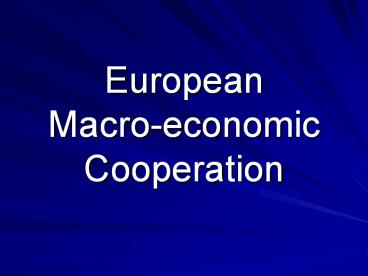European Macro-economic Cooperation - PowerPoint PPT Presentation
1 / 16
Title:
European Macro-economic Cooperation
Description:
early '87 - no realignment (until Sept. '92 crisis) ... April '83 - realignment less frequent. early '87 - nominal convergence improved steadily ... – PowerPoint PPT presentation
Number of Views:26
Avg rating:3.0/5.0
Title: European Macro-economic Cooperation
1
European Macro-economic Cooperation
2
Topics Covered
- Macro-economic cooperation under the Rome Treaty.
- Autonomy versus cooperation in a Mundell-Fleming
model. - New approaches to macro-economic policy making.
- The European Monetary System.
- Why beyond the EMS.
3
Macro-economic cooperation under the Rome Treaty
- Relations are characterised
- Heavy conditionality of the liberalisation
- A lack of binding commitments for macropolicy
makers - Open-ended escape and safeguard clauses
4
Two key ingredients have changed since the 1960s.
- First , After demise of Bretton Woods in 1971,
flexible exchange rates became much more populer
and the EC faced the issue of opting for a joint
float(with internal pegs). - Second , Economic analysis and policy experiences
have thoroughly altered the conduct of
macro-economic in EC countries.
5
Autonomy versus cooperation in a Mundell-Fleming
modelEffectiveness of fiscal and monetary
policies
Fiscal expansion Monetary expancion
Fixed Exchange rates Zero/low capital moderately effective ineffective Mobility High/perfect very effective ineffective Capital mobility
Flexible Exchange rates Zero/low capital moderately effective effective Mobility High/perfect ineffctive very effective Capital mobility
6
Mondel-Fleming Framework
- Monetary policy is used for external balance, and
fiscal policy is used for internal balance at
this model.Which is better for its
politics(interest) it is preferred.
7
New approaches to macro-economic policy making
- The New classical macro-economics is based on
four main ideas - Explicit attention for the supply side.
- Prices and wages change, and their responsivness
to other variables (or stickiness)
should be modelled.
8
- 3.Rational expectations about prices,
interest rates, exchange rates and wages in
other words, the future price level should be
modelled in such a way that it is consistent with
the information (economic agents are supposed to
possess) in the model.
9
- 4. Credibility of policies announced by the
authorities, especially with respect to
(lowering) inflation and maintaining a certain
exchange rate or target zones, are related to
expectations alter only slowly since a reputation
of credibility (espesially about disinflation)
has to be earned.
10
Monetary and fiscal policy effectiveness in new
classical models
Fiscal expansion Monetary expancion
Fixed Exchange rates expected effective ineffective Not anticipated effective ineffective
Flexible Exchange rates expected effective ineffective Not anticipated effective effective (temporary)
11
The European Monetary System
- Characteristing the European
Monetary System in 1979
Elements Specification
Goal Zone of monetary stability
Exchange Between the central banks(not the goverments) Rate Formally outside Community law Mechanism Central rates in ECU (ERM) Intervention obligations (symmetric) Re-alignment subject to common agreement
Credit Automatic,unlimited swap-facilities(up to 45days) Facilities between the central banks (called very short term) Short term fasilities up to 9 months between central banks, unconditional (they already existed before) Medium-term credits,conditional upon an applicants measures to promote economic convergence, and subject to an EC Council decision
12
Reserve 20 per cent of national gold and foreign exchanges pooling reserves to be deposited for three months, with automatik renewal, into the European Fund for Monetary Cooperation EFM could issue ECUs against these deposits (under a Council Regulation), but only for use among central banks
European Introduced by an EC Regulation Currency ECU is Unit - unit of account (for ERM - means of payment, only among central banks, but Countries only) receiver was obliged only to accept a max. of ECUs - legal tender for the system
Divergence Attempt to introduce symmetry and coordination Indicator Fixed at 75 per cent of the margin The indicator serves as a flashlight the country with (for ERM only) the deviating currency being subject to a presumption to act or otherwise explain in consultations why it did not act
13
The changing character of the EMS 1979 - 95
Period Charecteristics
March 79 - realignment frequent March 83 - nominal convergence limited - no reforms - methods(symmetric interventions, credit facilities) barely held EMS together
April 83 - realignment less frequent early 87 - nominal convergence improved steadily - no EMS reformss but Single Act introduced capital market liberalizations - more intra-marginal intervations
early 87 - no realignment (until Sept. 92 crisis) Sept.92 - incomplete convergence (in inflation and interest rates) - reforms (Basle-Nyborg and 1st stage EMU) - more currencies in ERM (UK, Spain, Portugal) - exchange controls abolished
Sept.92 - several realignments mid. 96 - lira and pound out of ERM - widening of band to (2 X ) 15 per cent - exchange rate stability / convergence restored in 94
14
Economic asessment of the EMS
Key Word Research question Assessment
Stability successful as a zone of monetary exchange-rate variability sharply reduced up to 1992 stability inflation strongly reduced, but not clearly due to EMS
Exchange control exchange rate stability due to capital Helpful short-run device before realignment (when controls? bigger han band, i.e. 4.5 per cent Emprical evidence on insultation very weak up to 92
Disinflation EMS reduced the costs of disinflation? No, because - emprical evidence for non-EMS not very diffrent - Germany can only lose in this thesis - exchange controls lower credibility
15
External shocks EMS, a shock-absorber Yes, because mechanism? - intra-EC shocks were symmetric - outside shocks no longer prompted divergent response
Symmetry was the actual functioning of No, because the EMS symmetric? - Germany anchor (n-1) - Germany not totally insulated
Growth has the EMS caused fiscal Probably not, because policy to be deflationary? - theoretically unlikely - emprical evidence at best ambiguous, if not weak
16
- Resource European Integration methods and
economic analysisJacques pelkmans































